
The Rotes Rathaus is the town hall of Berlin, Germany, located in the Mitte district on Rathausstraße near Alexanderplatz. It is the home to the governing mayor and the government of the state of Berlin. The name of the landmark building dates from the façade design with red clinker bricks.

Pegau is a town in the Leipzig district in Saxony, Germany, situated in a fertile plain, on the White Elster, 18 m. S.W. from Leipzig by the railway to Zeitz.

Vienna City Hall is the seat of local government of Vienna, located on the Rathausplatz in the Innere Stadt district. Constructed from 1872 to 1883 in a neo-Gothic style according to plans designed by Friedrich von Schmidt, it houses the office of the Mayor of Vienna, as well as the chambers of the city council and Vienna Landtag diet.

The New Town Hall is a town hall in Hanover, Germany. It opened on 20 June 1913 after construction lasting 12 years. A magnificent, castle-like building of the era of Wilhelm II in eclectic style at the southern edge of the inner city just outside the historic city centre of Hanover, the building is embedded within the 10-hectare (25-acre) Maschpark.

The New Town Hall is a town hall forms the northern part of Marienplatz in Munich, Bavaria, Germany. It hosts the city government including the city council, offices of the mayors and a small portion of the administration. In 1874 the municipality had left the Old Town Hall for its new domicile.
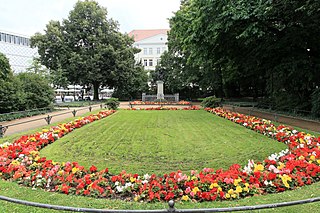
Goerdelerring is a street and major tram interchange station in Leipzig, Germany. It is named after Carl Friedrich Goerdeler.
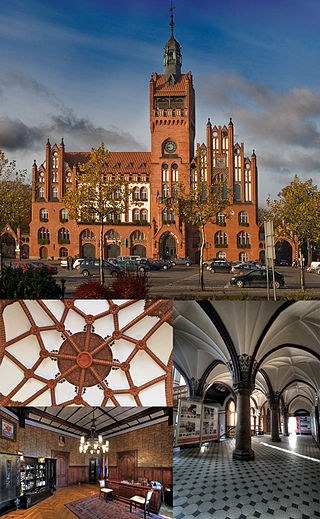
The Słupsk Town Hall is the chief administrative building of Słupsk, a town in northwestern Poland. The town hall was completed in 1901 in the Gothic Revival style and is a listed heritage monument protected by Polish law. The building continues to serve as the official residence of the town council.

The Historical City Hall of Münster, located in the centre of Prinzipalmarkt 10, is a well-known and much-visited landmark of the city of Münster, alongside Münster Cathedral, with over 120,000 visitors recorded at the site in 2012. It rose to prominence during the negotiations for the Peace of Westphalia Treaty of 1648, which concluded the Thirty Years' War in Western Europe; and the Eighty Years' War between Spain and the Republic of the Seven United Netherlands.

Gottlob Friedrich Thormeyer was a German representative of neoclassical architecture.
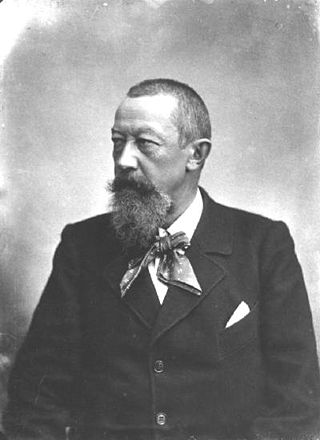
Hugo Georg Licht was a German architect.

Ratusha, Ivano-Frankivsk is a several stories-tall building in the downtown of the city of Ivano-Frankivsk, Ukraine. Formerly, it served as the town hall and now houses the Ivano-Frankivsk Regional History, Crafts and Culture Museum and an observation deck. It is located in the center, at the city's Market Square.
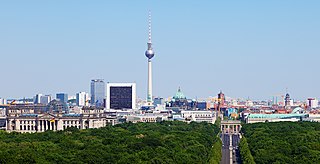
Berlin's history has left the city with an eclectic assortment of architecture. The city's appearance in the 21st century has been shaped by the key role the city played in Germany's 20th-century history. Each of the governments based in Berlin—the Kingdom of Prussia, the 1871 German Empire, the Weimar Republic, Nazi Germany, East Germany and the reunified Federal Republic of Germany—initiated ambitious construction programs, with each adding its distinct flavour to the city's architecture.

The New Town Hall has stood on the Domshof in the centre of Bremen, Germany since 1913. Located behind the Unser-Lieben-Frauen-Kirchhof cemetery, it is adjacent to the older section of the Town Hall with which it forms a harmonious ensemble. Among its sumptuous rooms decorated with local artefacts, the New Town Hall houses the Senate Chamber used by the Senate for its regular meetings and the Great Hall, a venue for official receptions. In 2004, Bremen Town Hall was listed as a UNESCO World Heritage Site, together with the Roland of Bremen, because of its outstanding architecture and testimony to the development of civic autonomy during the Holy Roman Empire.
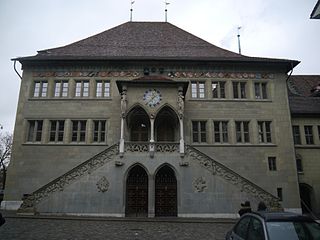
The Bern Town Hall is the building in Bern, Switzerland that houses the Grand Council of Bern, the Executive Council of Bern and the Grand Council of the City of Bern. The building is part of the UNESCO World Heritage Site of the Old City of Berne and is a Swiss heritage site of national significance.
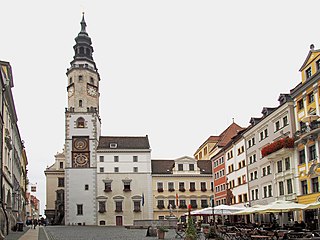
The Town Hall of Görlitz has been the place of the city's administration and jurisdictions since 1350. It was first mentioned in a document by the Görlitz council in 1369. Its interior dates back partly to the Renaissance period and baroque period. Over the centuries the administration grew, so did the town hall. It utilises several buildings of different epoches on the Lower Market Square 6–8.

The Old Town Hall, which dominates the east side of the Markt square in Leipzig's district Mitte, is considered one of Germany's most important secular Renaissance buildings. At the rear is the Naschmarkt. The mayor and the municipal administration have been housed in the New Town Hall since 1905.
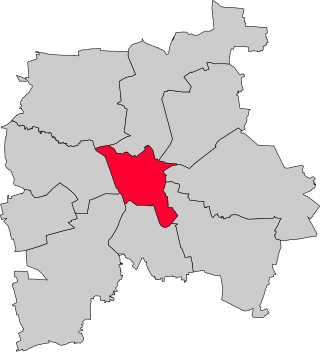
Leipzig-Mitte is one of ten boroughs (Stadtbezirke) of Leipzig, located in the center of the city. It includes numerous architectural monuments. Most of them are located in the subdivision "Zentrum", which is sited inside the Inner City Ring Road and the Promenadenring:

The Promenadenring Leipzig is the oldest municipal landscape park in Germany and one of the most important garden and cultural monuments in the city. The term is also used as a synonym for Leipzig's inner city ring road, a traffic facility that is connected to the green spaces of the Promenadenring. Like the inner city ring road, the promenade ring is about 3.6 kilometers long (2.24 mi.).

The Markt is a square of about 1 ha in Leipzig's district of Mitte, Germany. It is considered the center of the city. The Old Town Hall stands on it, which demonstrates its particular historical importance. The square was named Platz des Friedens from 1950 to 1954. Its paving is a listed heritage monument.




























